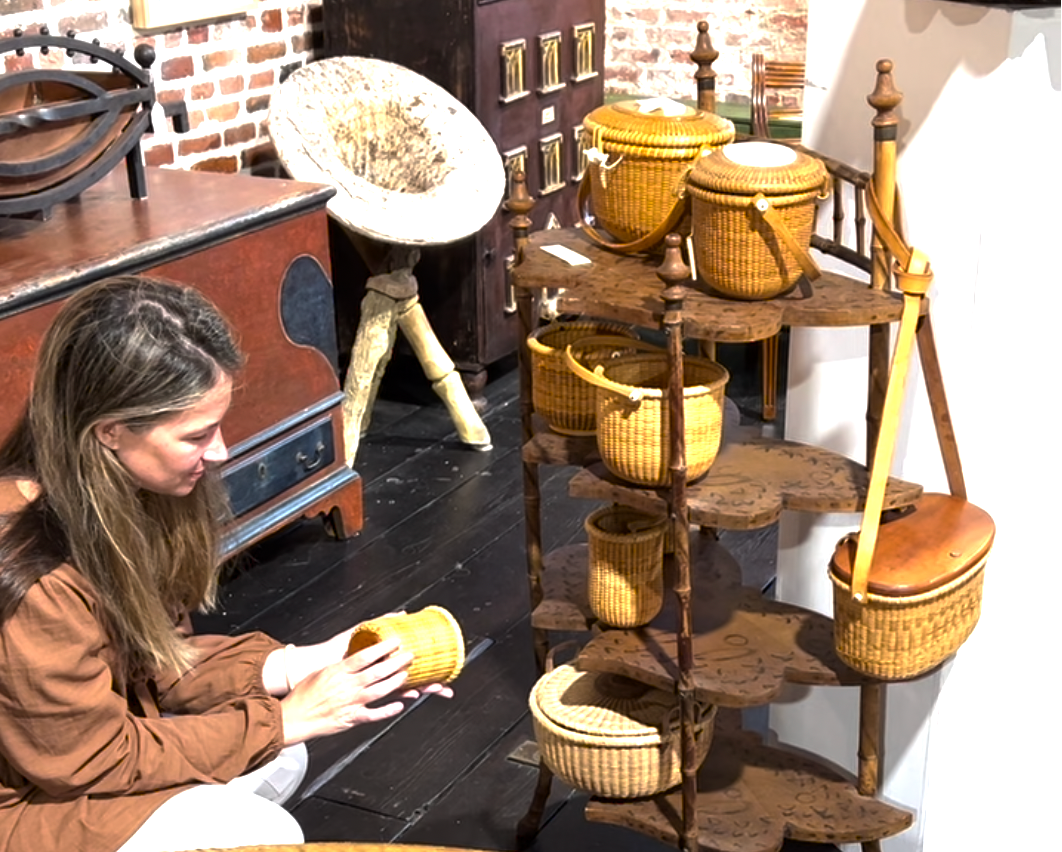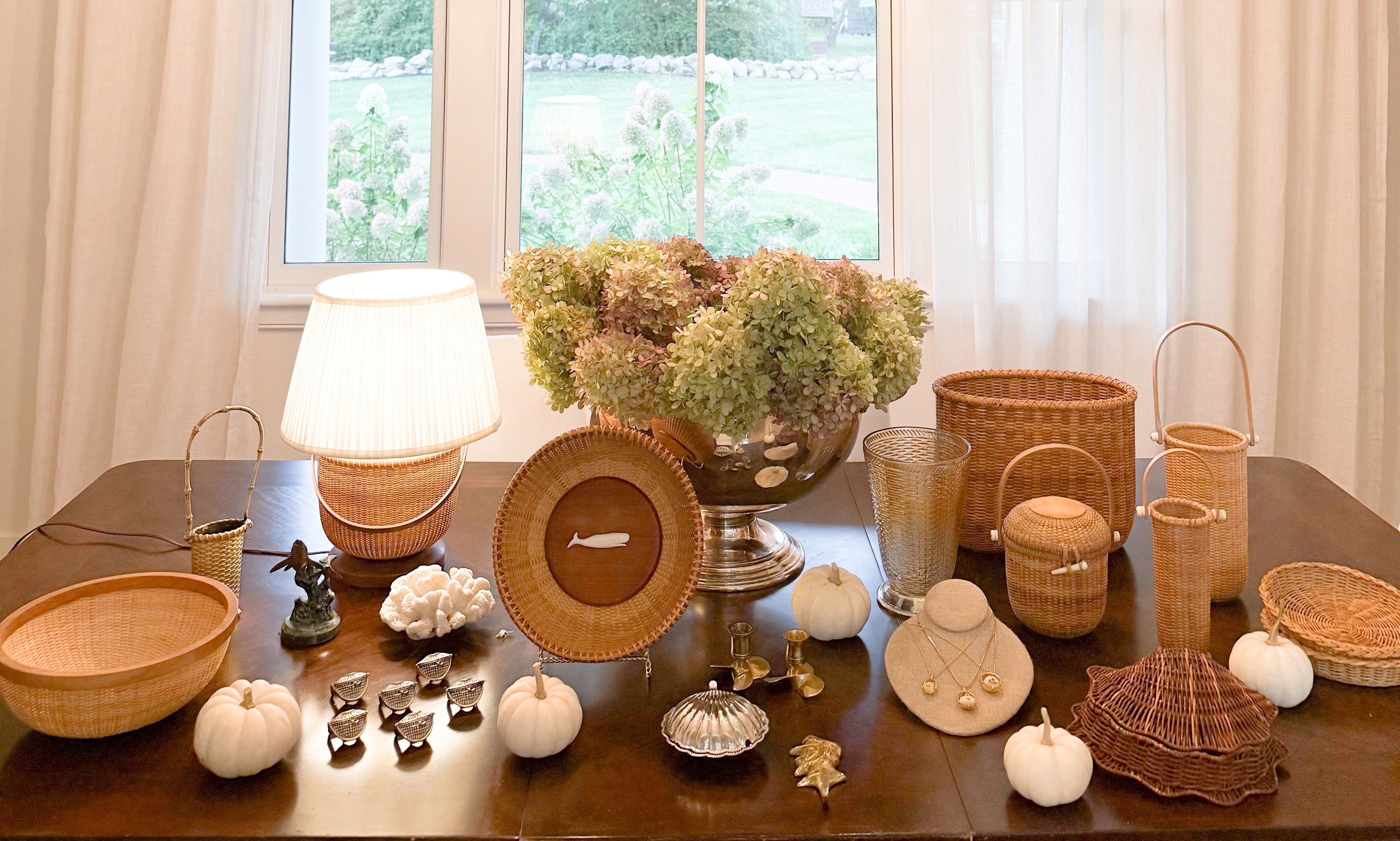
On the Roots of Craft: interweaving histories
Every so often, my work as a weaver and my background in art history sends me down a path that reveals more depth and meaning than I first imagined. What began as a curiosity about the deeper origins of Nantucket baskets became a more personal reckoning with the broader historical context of my craft within the canon of American basketweaving.
As I traced the history of these baskets that had so completely captivated my heart from the Whaling Museum on island to the Hood Museum of Art in New Hampshire, I couldn’t shake the feeling that there was meaning beyond what I was reading, coded into their connection to Native American basket weaving. Beyond similarities in form, what truly stopped me in my tracks was the overlapping timeline between when Native American basketry became popular souvenirs for coastal tourists and the origination of what we now call “lightship baskets,” also popular with visitors to the island.
Let’s back up: in the late 1800s and early 1900s, there was what is now called a "Basket Craze" where Indigenous baskets were very fashionable and thus highly sought after commodities. Native American tribes (women, mostly) would spend their winters weaving baskets not only for their own utilitarian and spiritual use, but as a means of financial survival in a post-colonial world. After so much had been taken from them, they found a market for their baskets among white tourists who appreciated the beauty of their indigenous craft. Come summer, they would pack up their creations and travel to set up what we’d now call “pop-ups,” selling their work in towns along the Eastern seaboard, as close to Nantucket as Cape Cod.
It was around this same time that the whaling industry that had fueled Nantucket’s economy was in decline. Out of financial necessity, the island began to shift its focus toward tourism. Nantucket baskets actually predate lightships, but as sailors moved from whaling ships to lightships, it makes sense that they too began to create baskets they could later sell as souvenirs to the island’s growing number of visitors. (Side note: they were later banned from doing so, yet the story and allure of their creation at sea, echoing the earlier lore of scrimshaw and whaling life, remain woven into the mythos.)
I began to feel uneasy about what that might mean, wondering if part of what I loved so much about this tradition might, however unintentionally, have roots in cultural appropriation. Worse still, I had already built a business profiting from my own woven pieces. As an art historian, I regretted that I hadn’t more significantly considered the broader historical context of Nantucket baskets beyond what was put in the brochure, so to speak.
I don’t think there was intentional harm in the overlap, just people adapting, making, and surviving as the world around them changed. But seen through the long lens of history, the exchange becomes more complicated, and that complexity deserves acknowledgment.
Engaging with the craft from all perspectives (admiring, collecting, weaving, and studying) has led me to a more layered appreciation of Nantucket baskets: their quiet precision and restraint, the generosity of the makers and instructors who sustain the tradition, and the profound artistry and spiritual resonance of Native American basketry that shaped its origins. “Two things can be true at once” has long been one of my favorite sayings, and it feels particularly fitting here.
I now weave in the way I was taught, but with a deeper awareness shaped by the Native American art I’ve studied and the values it carries: gratitude for the earth, respect for its resources, and reverence for the sacred beauty in what we create from them. That spirit guides everything I do in this space.
Just as most Nantucket basket weavers today espouse a desire to preserve history and tradition, I wish to respectfully weave into that the value of acknowledging and preserving the traditions of those whose homes, voices, and crafts were diminished by colonization.
It’s not perfect, and in time I hope to receive guidance to refine it, but after much reflection, I offer this -
A Land and Craft Acknowledgment
I acknowledge that the places I cherish and that inspire my work from Nantucket to my home in Newbury and beyond are the ancestral homelands of Native Americans. Their extraordinary craftsmanship and basket-weaving traditions undoubtedly informed the origins of other early American crafts.
I honor that legacy with reverence and aligned gratitude for the natural materials the earth provides.
Thank you for taking the time to read this reflection.
It’s a privilege to do this work: to make, to learn, and to weave together the hands and shared histories that came before us.
Warmly,
Katie
PS If you are interested in learning more about the Native American "Basket Craze" of the early twentieth century and feel called to do further reading, I would be happy / super enthused to help guide you to some excellent scholarly articles that help illuminate why this dialogue matters, so very much.


